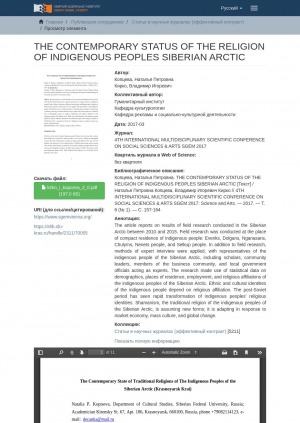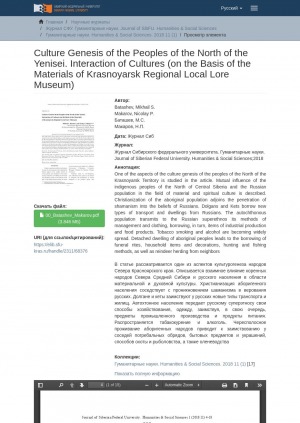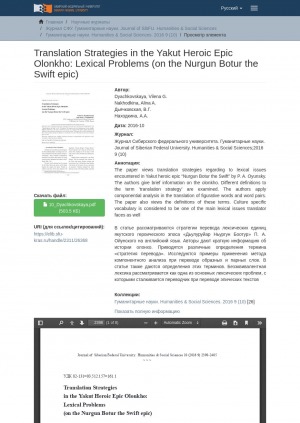- Книга (5086)
- Газета (30)
- Журнал (273)
- Автореферат диссертации (573)
- Изоиздание (5)
- Аудиоиздание (34)
- Видеоиздание (251)
- Картографическое издание (5)
- Неопубликованный документ (610)
- Нотное издание (16)
- Фотография (18)
- Статья (3387)
- Библиографический указатель (86)
- Словарь (11)
- Календарь (8)
- Брошюра (122)
- Буклет (35)
- Электронное издание (2)
- 3D-модель (17)
- Грампластинка (13)
- Веб-архив (787)
- Бурятский (2)
- Чукотский (8)
- Долганский (2)
- Английский (127)
- Эскимоский (3)
- Эвенкийский (11)
- Эвенский (85)
- Французский (17)
- Немецкий (6)
- Хантыйский (1)
- Киргизский (1)
- Корейский (1)
- Мансийский (1)
- Нанайский (1)
- Ненецкий (4)
- Нганасанский (2)
- Нивхский (1)
- Старорусский (11)
- Польский (6)
- Русский (9591)
- Латинская графика (91)
- Испанский (1)
- Таджикский (1)
- Тунгусский (2)
- Турецкий (5)
- Ульчский (1)
- Узбекский (1)
- Якутский (1374)
- Юкагирский (13)
- Литературно-художественные издания (582)
- Официальные издания (1128)
- Научные издания (4569)
- Научно-популярные издания (1989)
- Информационные издания (1446)
- Справочные издания (58)
- Учебные издания (952)
- Производственно-практические издания (21)
- Массово-политические издания (593)
- Изобразительное издание (31)
Количество страниц: 15 с.
Dobzhanskaya, O/ E. The Living Has Sound. The Dead Is Silent / Oksana E. Dobzhanskaya ; Moscow State University // Anthropology & archeology of Eurasia. - 2016, Т. 55, N 1. - С. 7-21. - DOI: http://dx.doi.org/10.1080/10611959.2016.1263485
DOI: http://dx.doi.org/10.1080/10611959.2016.1263485
Год выпуска: 2017
В статье сообщается о результатах полевых исследований, проведенных в Сибирской Арктике в период с 2010 по 2015 год. Полевые исследования проводились в местах компактного проживания коренных народов: эвенков, долган, нганасан, чулымцев, ненцев и селькупов. Помимо полевых исследований применялись методы экспертного интервью, где в качестве экспертов выступали представители коренных народов Сибирской Арктики: ученые, лидеры общин, представители бизнес-сообщества, представители органов местного самоуправления. В исследовании использовались статистические данные о демографических показателях, местах проживания, занятости и религиозных пристрастиях коренных народов Сибирской Арктики. Этническая и культурная идентичность коренных народов зависит от религиозной принадлежности. В постсоветский период произошла стремительная трансформация религиозной идентичности коренных народов. Шаманизм, традиционная религия коренных народов Сибирской Арктики, приобретает новые формы; он адаптируется к рыночной экономике, массовой культуре и глобальным изменениям
Год выпуска: 2014
Представлены результаты форсайт-исследования – сценирования будущего Республики Саха (Якутия), ее коренных народов. Обсуждаются выделенные экспертами как перспективные и реалистичные образы будущего республики. Представлено поле сценариев будущего Республики Саха (Якутия) в горизонте времени до 2050 г., обсуждаются сценарные условия и факторы. Описан базовый сценарий формирования многоукладных экономики и общества, сочетающих традиционный уклад, развитый индустриальный и постиндустриальный (когнитивный). В рамках базового сценария воспроизводство идентичности, культуры и языков коренных народов республики будет обеспечиваться специальной культурной политикой, культурными и образовательными практиками. Обозначены сценарии, альтернативные базовому: "корпоративная колонизация", "демографическая и культурная диссипация", "соблазн общества потребления", "культурный прорыв". Обсуждаются возможности "открытия Севера" для всего человечества, аналогично тому как в ХХ столетии происходило "открытие Востока". Условиями этого могут стать аккумуляция культурного наследия северных народов на основе использования современных информационных технологий; консолидация северных народов и перевод их культуры с уровня локальных этнических культур на уровень особого рода "северной цивилизации". Особой должна стать роль Северо-Восточного федерального университета как стратегического субъекта, организующего разработку и реализацию новых культурных, образовательных, здравоохранительных практик, необходимой культурной политики
Год выпуска: 2018
В статье рассматривается один из аспектов культурогенеза народов Севера Красноярского края. Описывается взаимное влияние коренных народов Севера Средней Сибири и русского населения в области материальной и духовной культуры. Христианизация аборигенного населения соседствует с проникновением шаманизма в верования русских. Долгане и кеты заимствуют у русских новые типы транспорта и жилищ. Автохтонное население передает русскому суперэтносу свои способы хозяйствования, одежду, заимствуя, в свою очередь, предметы промышленного производства и продукты питания. Распространяется табакокурение и алкоголь. Чересполосное проживание аборигенных народов приводит к заимствованию у соседей погребальных обрядов, бытовых предметов и украшений, способов охоты и рыболовства, а также оленеводства
Год выпуска: 2022
В статье прослеживаются и анализируются современные тенденции развития российского федерализма и их влияние на конституционно-правовое развитие Республики Саха (Якутия) как субъекта Федерации. Дается подробная характеристика изменений конституционного законодательства республики. Целью исследования является определение степени влияния федерального центра на конституционно-правовое развитие республики. В ходе исследования использовались исторический, технико-юридический и сравнительно-правовой методы. В статье современное конституционно-правовое развитие республики разделено на два этапа: с 1990 по 2000 годы и с 2000 года по настоящее время. Первый этап характеризуется относительной свободой республики в формировании своего конституционного пространства, включая государственно- территориальное устройство. Для следующего же этапа характерно последовательное почти полное ограничение ее конституционно-правовой самостоятельности. В современной России происходит довольно жесткое федеральное вмешательство в конституционно-правовое пространство субъектов Федерации, ограничивающее их свободу в определении механизмов взаимоотношений между органами государственной власти и установлении собственных государственно-правовых институтов. По мнению авторов, такое вмешательство оказывает негативное влияние на конституционно-правовое развитие Республики, и современной России, по меньшей мере, требуется самоограничение федеральной власти в сфере федеративных отношений и, как следствие, оптимизация конституционных механизмов разделения общефедеральных и региональных интересов
Год выпуска: 2018
В 1997 и в 2017 годах в Эвенкии были проведены комплексные исследования по современным этническим процессам с использованием метода массового опроса. Выявлены существенные изменения в хозяйстве, в разных областях материальной и духовной культуры. Резко снизилось значение оленеводства, в настоящее время в нем заняты около 1/10 части эвенкийских семей. Лучше сохранились охота и рыболовство, в них занята почти треть мужчин. На любительском уровне охотой и рыболовством занимается подавляющее большинство мужчин, а значительная часть женщин не утеряли навыков шитья и вышивки бисером. Активно идет процесс языковой ассимиляции, дети практически не говорят на языке эвенков и не понимают его, хотя большинство эвенков изучает родной язык в школе. Количество национально-смешанных семей, в основном с русскими, приблизилось к половине всех семей, большинство детей вливаются в эвенкийский этнос. В результате этих браков доля метисов среди эвенков приближается к 2/3, а среди детей их доля достигла 9/10. Эвенки превращаются в группу русскоязычных метисов, но с устойчивым этническим самосознанием и с сохранением элементов традиционной культуры в некоторых областях материальной и духовной культуры
Год выпуска: 2022
Целью и задачами статьи является выявление основных способов перевода на русский текста якутского героического эпоса олонхо "Ала-Булкун", осуществленного якутским лингвистом и писателем Г.В. Баишевым-Алтан-Сарын (1898-1931). В качестве материала исследования были выбраны глаголы движения и некоторые основные эпические формулы, использованные в данном олонхо. Анализ способов перевода на русский язык якутских глаголов движения показывает, что эти глаголы переведены на русский язык способом замены. Подобный факт свидетельствует о том, что переводчик стремился точно передать семантику якутских глагольных форм на русский язык. Это, свою очередь, обусловлено тем, что глагольные формы как предикативные структуры являются вершинами тех или иных предикативных конструкций – зависимых или независимых. Эпические формулы переведены при помощи синтаксической замены – параллелизмами, а также расчленением предложения на несколько предложений. Кроме того, встречаются лексические и синтаксические повторы для расширения контекста с целью более медленного раскрытия передаваемой информации. Установлено, что в рассмотренном переводном тексте имеют место элементы авторизованного перевода. Изучение особенностей подобных переводов олонхо, ориентированных на воспроизведение стилистических и поэтических особенностей данного жанра якутского фольклора, имеет как практическое, так и теоретическое значение
Год выпуска: 2022
Настоящая статья представляет формирование субэтнической группы якутов в исследовательской траектории: ландшафт, история, память и посвящена изучению периферийной этнолокальной группы ессейских якутов, компактно проживающих на озере Ессей Красноярского края с XVIII века. На основе полевых материалов реализованы методы опроса, картографирования, глубинного интервью, введены в научный оборот ранее не опубликованные архивные материалы, нарративные источники
Год выпуска: 2018
В статье рассматривается "сильный" текст якутской культуры - олонхо "Нюргун Боотур Стремительный" Ойунского. Убедительным свидетельством "силы" текста Ойунского является его неизменная популярность среди носителей языка, устойчивый интерес исследователей к авторской версии эпоса, его высокий образовательный и культурный потенциал, а также регулярная переводимость на языки вербальной и невербальной семиотических систем. Являясь классическим образцом эпической традиции, олонхо демонстрирует тесную связь с реальной жизнью якутов и подлинность описываемых событий, что делает текст Ойунского надежным историко-этнографическим источником сведений о культуре и истории народа саха. Наряду с культурной информацией важное место в сложном информационном континууме олонхо занимает культурная память, возникающая в результате мифологизации и сакрализации прошлого коренного народа саха, имеющая коллективный характер и обеспечивающая культурную идентичность этнической группы. В настоящем исследовании рассматриваются культурная информация и память, отражающие уникальный культурный код "сильного" текста (прежде всего в транслингвистической и транскультурной перспективах), и выявляются эффективные стратегии сохранения во вторичных текстах якутского исторического опыта и родовой памяти. Понимание реципиентами текста олонхо, несмотря на его сложный культурный смысл, и способность продолжать его "жизнь" в "родной" и "чужой" культурах предполагает интерпретацию и адаптацию информации эпического произведения средствами вербальной и невербальной семиотики. Вторичные тексты олонхо различной семиотической природы сохраняют культурную информацию и память об оригинальном тексте, что доказывает универсальность данного типа информации как единицы перевода эпической литературы
Год выпуска: 2016
В статье рассматриваются стратегии перевода лексических единиц якутского героического эпоса "Дьулуруйар Ньургун Боотур" П. А. Ойунского на английский язык. Авторы дают краткую информацию об истории олонхо. Приводятся различные определения термина "стратегия перевода". Исследуются примеры применения метода компонентного анализа при переводе образных и парных слов. В статье также даются определения этих терминов. Безэквивалентная лексика рассматривается как одна из основных лексических проблем, с которыми сталкивается переводчик при переводе эпических текстов









